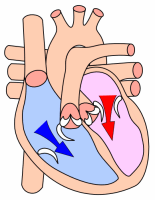Diastole

|
WikiDoc Resources for Diastole |
|
Articles |
|---|
|
Most recent articles on Diastole |
|
Media |
|
Evidence Based Medicine |
|
Clinical Trials |
|
Ongoing Trials on Diastole at Clinical Trials.gov Clinical Trials on Diastole at Google
|
|
Guidelines / Policies / Govt |
|
US National Guidelines Clearinghouse on Diastole
|
|
Books |
|
News |
|
Commentary |
|
Definitions |
|
Patient Resources / Community |
|
Directions to Hospitals Treating Diastole Risk calculators and risk factors for Diastole
|
|
Healthcare Provider Resources |
|
Causes & Risk Factors for Diastole |
|
Continuing Medical Education (CME) |
|
International |
|
|
|
Business |
|
Experimental / Informatics |
Editor-In-Chief: C. Michael Gibson, M.S., M.D. [1]
Diastole is the period of time when the heart relaxes after contraction. Ventricular diastole is when the ventricles are relaxing, while atrial diastole is when the atria are relaxing.
Inside the heart
During ventricular diastole, the pressure in the (left and right) ventricles drops from the peak that it reaches in systole. When the pressure in the left ventricle drops to below the pressure in the left atrium, the mitral valve (bicuspid valve) opens, causing accumulated blood from the atrium to flow into the ventricle.
Inside the arteries
The adjective "diastolic" is used to refer to the relaxation of the heart between muscle contractions. It is used to describe portions of the cardiac cycle related to contraction. More typically it is used as one component of measurement of blood pressure. "Diastolic pressure" refers to the lowest pressure within the arterial blood stream occurring during each heart beat. The other component of blood pressure is systolic pressure, which refers to the highest arterial pressure during each heart beat. When stating blood pressure, systole and then diastole is mentioned; for example: 120/80.
See also
External links
da:Diastole de:Diastole it:Diastole nl:Diastole nn:Diastole sv:Diastole